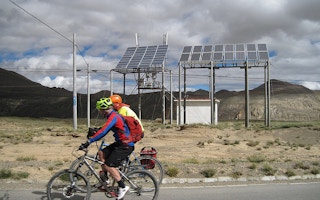More than 30 per cent of Nepalese have never used electricity. The other 70 per cent live with blackouts that can extend up to 16 hours a day during the winters, or are using solar panels to light their houses.
On paper, though, Nepal should be energy rich. It has 2 per cent of the world’s water resources and is the second most water-rich country in the world. It also has more than 300 days of sunshine in a year. Unfortunately neither hydropower nor solar power has been effectively harnessed to provide the majority of its population with electricity, much less to power industrial growth.
Nepal was an early mover on hydropower, and installed a 500 Kilowatt (KW) hydropower project in the small town of Pharping – 20 kilometres south of the Kathmandu valley – with support from Britain in 1911. This was just 29 years after the first hydropower project was installed in Wisconsin, in the US, and one year before China built its first hydropower project.
Since then, though, Nepal has only harnessed 680 MW of its estimated 40,000 MW hydropower potential capacity (actual capacity is 83,000 MW, but much of it is technically and economically not feasible to harness).
Amrit Lal Nakarmi, a professor at the Centre for Energy Studies at the Institute of Engineering, said this was because the “politicians are providing a Hobson’s choice — a situation in which there is only one real choice offered – by saying that economic prosperity is only possible by developing big hydropower projects and selling energy to neighbouring countries. But they have always ignored tapping other renewable resources like solar, wind.” As a result, the country has been able to produce only about 15 MW from solar power and about 20 KW from wind in the last two decades.
“
Hydropower is the biggest source of energy now, and will be in the future as well, but with efficient and cheaper solar and other renewable technologies available, there is no need to wait to reach out to those without electricity access.
Govinda Raj Pokharel, former vice-chair, National Planning Commission, Nepal
Meanwhile, while the sun shines brightly all year and the rivers flow fast, diesel filled oil tankers provide the fuel to power generators in cities that produce almost as much electricity as the hydropower plants produce. Nepal spends more than NPR 100 billion (USD 1 billion) to import petroleum products from India.
“This is a self-created mess and nobody is going to solve it,” said Dipak Gyawali, a water resources expert and former water resources minister of Nepal, “until they manage to forget the big hydropower projects, and dreams of exporting electricity.”
The problem is that such large projects require a great deal of investment. “Hydropower is the biggest source of energy now, and will be in the future as well, but with efficient and cheaper solar and other renewable technologies available, there is no need to wait to reach out to those without electricity access,” said Govinda Raj Pokharel, former vice-chair of the National Planning Commission who once headed the country’s alternative energy centre.
He also emphasised that a significant number of such people are not connected to the grid, and thus would not be able to access the electricity generated by hydropower projects, even if they came up overnight.
This story was published with permission from The Third Pole.

















